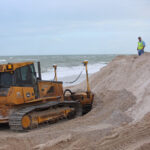The following document was taken directly from and is available on the Indian River County Emergency Services website www.IRCES.com:2004 Hurricane Season Summary
The 2004 Hurricane Season was an active season and will be known as one of the most damaging hurricane seasons in history.
With over $22 billion in property damage to Florida and the United States so far, the damage totals will likely exceed the 1992 Hurricane Andrew damage costs. Also, this hurricane season was one of the deadliest with over 2000 deaths attributed to Hurricane Jeanne as flooding rains moved over Haiti. An accurate death total is difficult in Haiti because so many people were killed by mudslides and remain buried.
Tropical cyclones developed in the Gulf of Mexico, the Caribbean Sea, and the intertropical convergence zone of the Atlantic Ocean. This year, Florida experienced the full strength of the Cape Verde type storms with four (4) hurricanes making landfall across the state. Hurricane Charley made landfall over southwest Florida with winds of 145 mph. The system traveled over central Florida, creating severe damage to property and infrastructure. Hurricane Ivan made landfall near Pensacola with winds of 130mph, creating severe storm surge damage and flooding.
Indian River County experienced direct impacts from Hurricane Frances and Hurricane Jeanne. This was an unprecedented hurricane season for Indian River County because we had never had a hurricane with winds over 100mph and in 2004 we had two (2). First, Hurricane Frances with sustained winds of 105mph and then our first major hurricane (winds over 111mph) when Hurricane Jeanne made landfall with sustained winds of 120mph. With both hurricanes, Indian River County’s damage cost is near $3 billion.
During 2004, the Atlantic region has had 15 tropical cyclones, of which 14 became named storms, of which 8 of the named storms became hurricanes, of which 6 of the hurricanes became major hurricanes. The following chart compares actual activity to Dr. Gray=s official forecast for the 2004 season:
ACTUAL vs. Dr. GRAY’s FORECAST
(May 28, 2004)
Named Storms 14 / 14
Hurricanes 8 / 8
Major Hurricanes 6 / 3
As you can see, Dr. Gray’s forecast was almost exact for the actual activity that
occurred. Of the 15 tropical cyclones this year, 7 made landfall somewhere in the
United States. The following is a review of the landfalling tropical cyclones during
2004.
SYSTEM WINDS LANDFALL LOCATION
Tropical Storm Bonnie 65mph Florida Panhandle
Hurricane Charley 145mph Charlotte County, Fl.
Hurricane Frances 105mph Martin County, Fl.
Tropical Storm Gaston 70mph South and North Carolina
Hurricane Ivan 130mph Alabama/Western Fl. Panhandle
Hurricane Jeanne 120mph Martin County
Tropical Storm Matthew 45mph Northern Gulf States
For Florida, the landfall of 4 hurricanes can be attributed to a few meteorological factors. First, the unusual expansion of the Bermuda high pressure ridge over the Florida peninsula. This ridge expansion prevented the hurricanes from making the familiar turn northwest and north as they approach Florida. Second, very little upper level wind shear. The lack of wind shear allowed for six (6) hurricanes to become major hurricanes.
Finally, very warm Atlantic surface water temperatures. The warm temperatures allowed for rapid intensification and sustained major hurricane status for several days.
This was the second year for the 5 day forecast from the National Hurricane Center. While Indian River County residents did not like the forecast, the 4-5 day projections were accurate and provided plenty of time for everyone to prepare. The actual landfall areas may have changed, but the general area of hurricane force winds remained constant and no one was surprised. Once again, it is important for everyone to watch the hurricane force wind area and not center on the exact landfall track. The Hurricane Watches and Warnings provided good coverage of the actual winds experienced during all hurricanes over Florida. As we look to the future, scientists at the National Hurricane Center will be focusing on improving the intensity forecast. The intensity forecast continues to be difficult as researchers try to develop an accurate intensity model.
Looking ahead to 2005, we can expect to see another above average year for tropical cyclone development. The big factor for the 2005 season will be the development or absence of the El Nino phenomenon in the Eastern Pacific Ocean. El Nino data will be available in April, 2005. Also, over the winter and spring, we will be watching the development of the Bermuda high pressure ridge to see how far west the ridge will expand.
The following is a list of the tropical cyclones for the 2004 Hurricane Season:
NAME DATES HIGHEST WINDS
Hurricane Alex July 31-August 6, 120 mph
Tropical Storm Bonnie August 3-12, 65 mph
Hurricane Charley August 9-14, 145 mph
Hurricane Danielle August 13-21, 105 mph
Tropical Storm Earl August 13-15, 45 mph
Hurricane Frances August 24-September 9, 145 mph
Tropical Storm Gaston August 27-September 1, 70 mph
Tropical Storm Hermine August 29-31, 40 mph
Hurricane Ivan September 2-24, 165 mph
Hurricane Jeanne September 13-29, 120 mph
Hurricane Karl September 16-24, 140 mph
Hurricane Lisa Sept. 19-October 3, 75 mph
Tropical Storm Matthew October 8-10, 45 mph
Tropical Storm Nicole October 10-11, 50 mph
Tropical Depression #10 September 7-9, 35 mph
The 2004 Hurricane Season officially ends today (November 30, 2004). However, we are watching a potential tropical system over the central Atlantic. Even if this system develops, it will not threaten the United States. No further tropical activity is expected for Florida this year.
Submitted By,
Nathan B. McCollum
Emergency Management Coordinator
Department of Emergency Services






